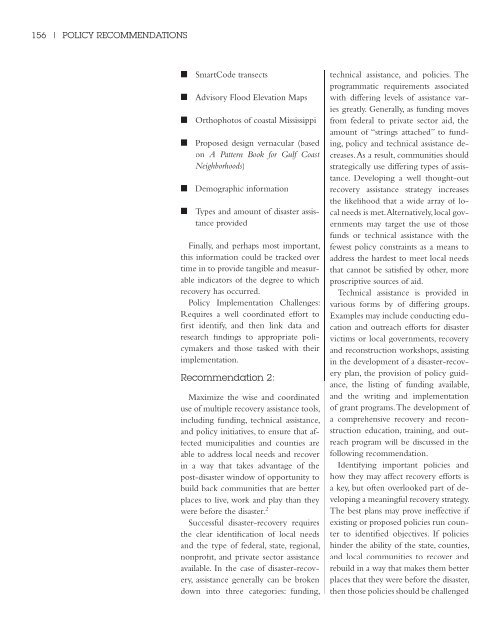Reports - Mississippi Renewal
Reports - Mississippi Renewal
Reports - Mississippi Renewal
- No tags were found...
You also want an ePaper? Increase the reach of your titles
YUMPU automatically turns print PDFs into web optimized ePapers that Google loves.
156 | POLICY RECOMMENDATIONS■ SmartCode transects■ Advisory Flood Elevation Maps■ Orthophotos of coastal <strong>Mississippi</strong>■ Proposed design vernacular (basedon A Pattern Book for Gulf CoastNeighborhoods)■ Demographic information■ Types and amount of disaster assistanceprovidedFinally, and perhaps most important,this information could be tracked overtime in to provide tangible and measurableindicators of the degree to whichrecovery has occurred.Policy Implementation Challenges:Requires a well coordinated effort tofirst identify, and then link data andresearch findings to appropriate policymakersand those tasked with theirimplementation.Recommendation 2:Maximize the wise and coordinateduse of multiple recovery assistance tools,including funding, technical assistance,and policy initiatives, to ensure that affectedmunicipalities and counties areable to address local needs and recoverin a way that takes advantage of thepost-disaster window of opportunity tobuild back communities that are betterplaces to live, work and play than theywere before the disaster. 2Successful disaster-recovery requiresthe clear identification of local needsand the type of federal, state, regional,nonprofit, and private sector assistanceavailable. In the case of disaster-recovery,assistance generally can be brokendown into three categories: funding,technical assistance, and policies. Theprogrammatic requirements associatedwith differing levels of assistance variesgreatly. Generally, as funding movesfrom federal to private sector aid, theamount of “strings attached” to funding,policy and technical assistance decreases.As a result, communities shouldstrategically use differing types of assistance.Developing a well thought-outrecovery assistance strategy increasesthe likelihood that a wide array of localneeds is met. Alternatively, local governmentsmay target the use of thosefunds or technical assistance with thefewest policy constraints as a means toaddress the hardest to meet local needsthat cannot be satisfied by other, moreproscriptive sources of aid.Technical assistance is provided invarious forms by of differing groups.Examples may include conducting educationand outreach efforts for disastervictims or local governments, recoveryand reconstruction workshops, assistingin the development of a disaster-recoveryplan, the provision of policy guidance,the listing of funding available,and the writing and implementationof grant programs. The development ofa comprehensive recovery and reconstructioneducation, training, and outreachprogram will be discussed in thefollowing recommendation.Identifying important policies andhow they may affect recovery efforts isa key, but often overlooked part of developinga meaningful recovery strategy.The best plans may prove ineffective ifexisting or proposed policies run counterto identified objectives. If policieshinder the ability of the state, counties,and local communities to recover andrebuild in a way that makes them betterplaces that they were before the disaster,then those policies should be challenged




